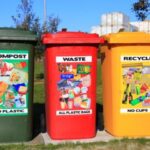Hazardous waste causes a great threat to the environment which is why industrial and construction companies require professional help when it comes to disposing of hazardous waste. You may be wondering what makes hazardous waste so dangerous to humans, the environment, and living creatures. Read our blog post about hazardous waste to find out its definition, examples, risks, and threats, and many more details on this topic.
Hazardous Waste
Hazardous waste is defined as the type of waste that has a serious or potential threat to human health, the environment, or both. Hazardous waste may come in the form of liquids, solids, gases, or sludges, and can result from a wide range of sources, such as industrial processes, chemical manufacturing or creation, medical facilities, and households.
What makes hazardous waste difficult to handle sometimes is that it has various physical forms, such as solid, liquid, and gas, making the process of handling it difficult and harmful to anyone who comes in contact with it.
Industries that Produce Hazardous Waste
There are several industries that produce hazardous waste, such as industrial facilities, healthcare facilities, households, and many others. Here are some of the main producers of hazardous waste in the world:
- Industrial Facilities: Chemical factories, oil refineries, and manufacturing facilities produce a large amount of hazardous waste.
- Healthcare Facilities: Hospitals, clinics, and other medical facilities produce a significant amount of hazardous waste, including medical gear and pharmaceuticals.
- Laboratories: Research facilities, testing laboratories, and other scientific institutions which use hazardous materials in their workspaces.
- Household and Commercial Waste: Hazardous waste can also come from homes and businesses, including electronics, batteries, and cleaning products.
- Agricultural Procedures: Agricultural activities can produce hazardous waste, like pesticides and fertilizers, which can cause harm to human health, animals, and the environment.
- Construction and Demolition: Construction and demolition processes can produce hazardous waste, including asbestos, lead, and other constituents that can cause health and environmental complications if not professionally dealt with.
Examples of Hazardous Waste

We collected some hazardous waste types to help you get a closer look into this dangerous type of waste, and here are the types of hazardous waste:
- Chemicals: acids, alkalis, solvents, pesticides, herbicides, and cleaning products
- Metallic elements: lead, mercury, chromium, and cadmium
- Electronics: computers, televisions, and phones
- Medical waste: infectious waste, sharps, and pharmaceuticals
- Radioactive materials: nuclear waste and polluted apparatus
Threat of Hazardous Waste
Hazardous waste could cause many issues and health risks to humans who come in contact with it. They might suffer from inhalation issues, troubles with digestion, and skin problems in the case of physical contact.
Regarding the environment, hazardous waste can pollute the soil, water, and air, resulting in environmental degradation, hence spoiling wildlife in all aspects. This can have lifelong effects on the environment, and even pose risks to human health through the food chain. For example, if a farm is contaminated with hazardous waste, then all of its products from fruits and vegetables will be polluted and become inedible, increasing food waste issues and harming human health if the crops are distributed to the markets.
One of the threats of hazardous waste is safety issues and the risk of fire and explosions. Some hazardous waste materials are flammable or explosive, resulting in fires or explosions and causing huge damage to properties while threatening human lives.
Hazardous Waste Management in Qatar

Almost all hazardous waste management in Qatar is done professionally by experts who abide by the environmental guidelines of the nation. In order to help local authorities in Qatar treat hazardous waste at the highest levels of care, Qatar MCC offers its services in hazardous waste management to industrial companies and construction sites.
Hazardous waste goes through several steps when managed and processed. Firstly, it is identified and categorized according to the type of waste. Secondly, any type of hazardous waste is supposed to be stored in containers that are suitable for the waste type, and stored in a way that minimizes the risk of release or contamination. Thirdly, the waste is then transported by professionals like Qatar MCC who have the required trucks for the mission. After that, the waste gets treated carefully and disposed of in several ways like recycling, landfilling, and incineration through the hazardous waste incinerator which helps greatly in overcoming the increase of this type of waste.
Hazardous Waste Transportation in Qatar
When it comes to transporting hazardous waste, several factors should be taken into consideration to protect the environment and humans:
- Clear proper labeling and marking of the hazardous waste containers
- Well-maintained vehicles and trucks that meet specific requirements
- Professional transporters and personnel who know the risks of this process
With Qatar MCC, rest assured that your business waste will be transported professionally.
Buying Waste Bins in Qatar

One of the solutions to deal with hazardous waste onsite is buying hazardous waste bins with huge capacity and powerful materials like the 660 litre yellow medical bin
Secure your industrial or construction space today by getting the highest-quality bins in Qatar from MCC!
FAQs
What is non-hazardous waste?
Non-hazardous waste is the type of waste that doesn’t cause any serious threat or harm to the environment, animals, or humans. Food waste and yard waste are some types of non-hazardous waste in any environment, and they don’t require special treatment like the one required for hazardous waste.
How to dispose of hazardous waste?
Hazardous waste treatment takes several stages starting from collection and classification to transportation and incineration.
We reached the end of our blog post on hazardous waste and everything related to it; we covered its implications, threats, examples of hazardous waste, and the main industries that produce hazardous types of waste. Keep an eye on our blog and if you are looking for waste management services by MCC in Qatar or hazardous waste removal services, then don’t hesitate to contact MCC to get an immediate quote on your requests.



